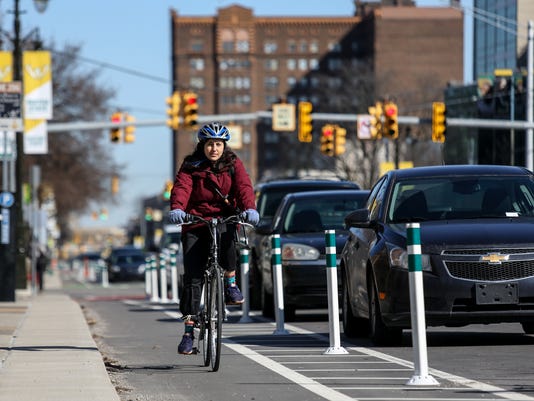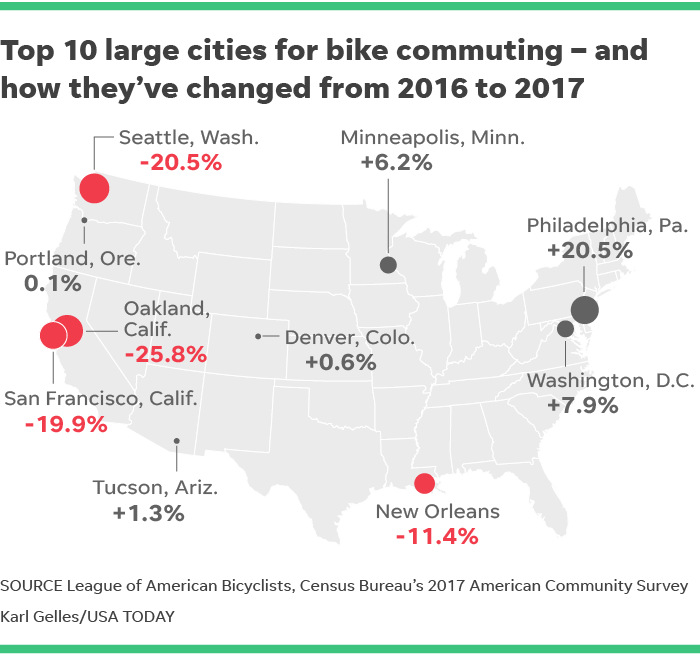Chris Woodyard, USA TODAY; article contains an additional video

image from article
LOS ANGELES – On Thursdays, Charles Dandino becomes the conductor of an unusual kind of train.
He leads what he calls a "bike train," a group of cycling coworkers who band together for their six-mile ride to work in the name of safety, as well as for fun and exercise.
Around the country, city transportation officials wish there were more bicyclists like Dandino, as they seek to cut traffic congestion, promote health and identify alternatives to cars. But after rising for several years, the percentage of commuters turning to bikes has declined for the third year straight, U.S. Census Bureau figures shows.
Nationally, the percentage of people who say they use a bike to get to work fell by 3.2 percent between 2016 and 2017, to an average of 836,569 commuters, according to the bureau's latest American Community Survey, which regularly asks a group of Americans about their habits. That's down from a high of 904,463 in 2014, where it peaked after four straight years of increases.
In some cities, the decline was far more drastic. In Tampa, Florida, and Cleveland, Ohio, cycling to work dropped by at least 50 percent, although in some cities, cycling to work was up just as dramatically.
Experts offer several explanations for the nationwide decrease that has unfolded even as cities have spent millions trying to become more bike friendly.
Most obviously, lower gasoline prices and a stronger economy have contributed to strong auto sales and less interest in cheaper alternatives, like mass transit and bikes. Also, the rise of ride-hailing services like Uber and Lyft and electric scooters have cut into bike commuting, said Dave Snyder, executive director of the California Bicycle Coalition.
Another bike advocacy group, the League of American Bicyclists, found a mix when it examined biking trends in the 70 largest cities based on its own analysis of Census data. Bike commuting was up slightly between 2016 and 2017 in one of the large cities where it is most popular, Portland, Oregon. Now, 6.3 percent of commuters there bike to work. It was also up in the second and third most popular big biking cities, Washington, D.C., and Minneapolis, Minnesota.
But it was down 19.9 percent in fourth-place San Francisco, 11.4 percent in fifth-place New Orleans and 20.5 percent in sixth-place Seattle over the same one-year time period.
"It shows that while we have made investments over the last 20 years," in bicycle infrastructure, "we are still far from having safe and connected networks that make people feel safe biking to work," said Ken McLeod, the league's policy director.
Federal highway spending on bike- and pedestrian-related improvements totaled $915.8 million this year. While they have varied from year to year, they have generally doubled over the last 10 years, figures show.
But "this level of spending is relatively small given the needs for bicycle and pedestrian infrastructure," McLeod said.
City officials around the country say they continue to try to support bike commuters. Besides new bike lanes and trails, many have added bike sharing programs, as well, which give cyclists the ability to rent a bike to ride point-to-point or for the day.
Besides the one-year drop in Seattle, the city saw a 19 percent dropoff between 2011 and 2017, according to the league's report. Dawn Schellenberg, spokeswoman for the city Department of Transportation, said it may be due to the city's famously rainy weather or commuters using bikes for only part of their trips, using them to connect to public transit.
One of the aims of the city initiative Go Healthy Houston is to make it easier for residents to exercise. Recently, the city unveiled its first protected bike lane, which keeps cyclists safe from car and truck traffic and makes it easier to commute. Laura Ungar, USA TODAY
In Austin, Texas, there was a 24.1 percent drop in bike commuters between 2016 and 2017, and a 38 percent decline between 2011 and 2017. City officials say they have a strategy to increase ridership by concentrating their biking infrastructure efforts on trips up to three miles that are "very doable by bike," said Laura Dierenfield, the city's division manager of active transportation.
"We want to to make it possible for people to have a variety of choices about how they get around," she said.
Long Beach, California, saw a 23.1 percent increase in the number of bike commuters between 2016 and 2017, though it was down 19 percent between 2011 and 2017, the league's report says. Over the past decade, Long Beach has added bike lanes throughout the city and dedicated routes separated from traffic throughout the city, including some that recently opened. Its bike sharing program continues to grow, now with 11,000 members.
"I think we are getting a lot of commuters coming into the downtown," said Public Works Director Craig Beck. "A separated bike lane that goes four blocks doesn't really do anything. It's about point-to-point safety."
For bike commuters, safety is a top consideration.
In a push to make the city more bike friendly, Los Angeles started installing miles of protected bike lanes and embracing "road diets," or slowing streets to make them safer for bikers and pedestrians. But in a city where the car is king, a backlash from motorists drastically cut back those efforts.
As a result, Bicycling magazine named Los Angeles the worst biking city in America in October.
"The City Council and the mayor's office are only listening to angry drivers who don't want their commute to be slowed down by anyone," said Ted Rogers, a veteran bike rider who writes the BikingInLA blog.
"I hear from countless people who say they quit," biking, he said. "They just don't feel safe on the streets anymore."
Safety was one of the key reasons that Dandino said he created his bicycle train six years ago. He started by recruiting co-workers to meet early at a coffee shop in the old business section of Pasadena, California, to ride together to work at NASA's Jet Propulsion Laboratory.
A bike devotee, Dandino, 31, said it was tough at first to find volunteers. He said he now will have about eight riders on a typical day, the numbers swelling to as many as 15 when there are more interns.
"Riding bikes in a group is more thrilling and a joy to do," said Dandino, a mechanical engineer. "On the safety side, it makes us much more visible and there's strength in numbers."
As the self-described conductor, Dandino said he makes the group keep together and is ready to fix flats or help with other bike repairs if a rider needs it.
Barbara Insua used to ride regularly with Dandino's bike train. She said she loved getting a workout on the way to her job as a graphics designer. "Uphill to work. Downhill home," she said. But then she bought a new car and stopped riding.
Now, with her 50th birthday looming, she said she's inspired to join the train again.
"I am going into a phase in which I want to come back to biking," Insua said. "There are so many wonderful things about biking."

No comments:
Post a Comment